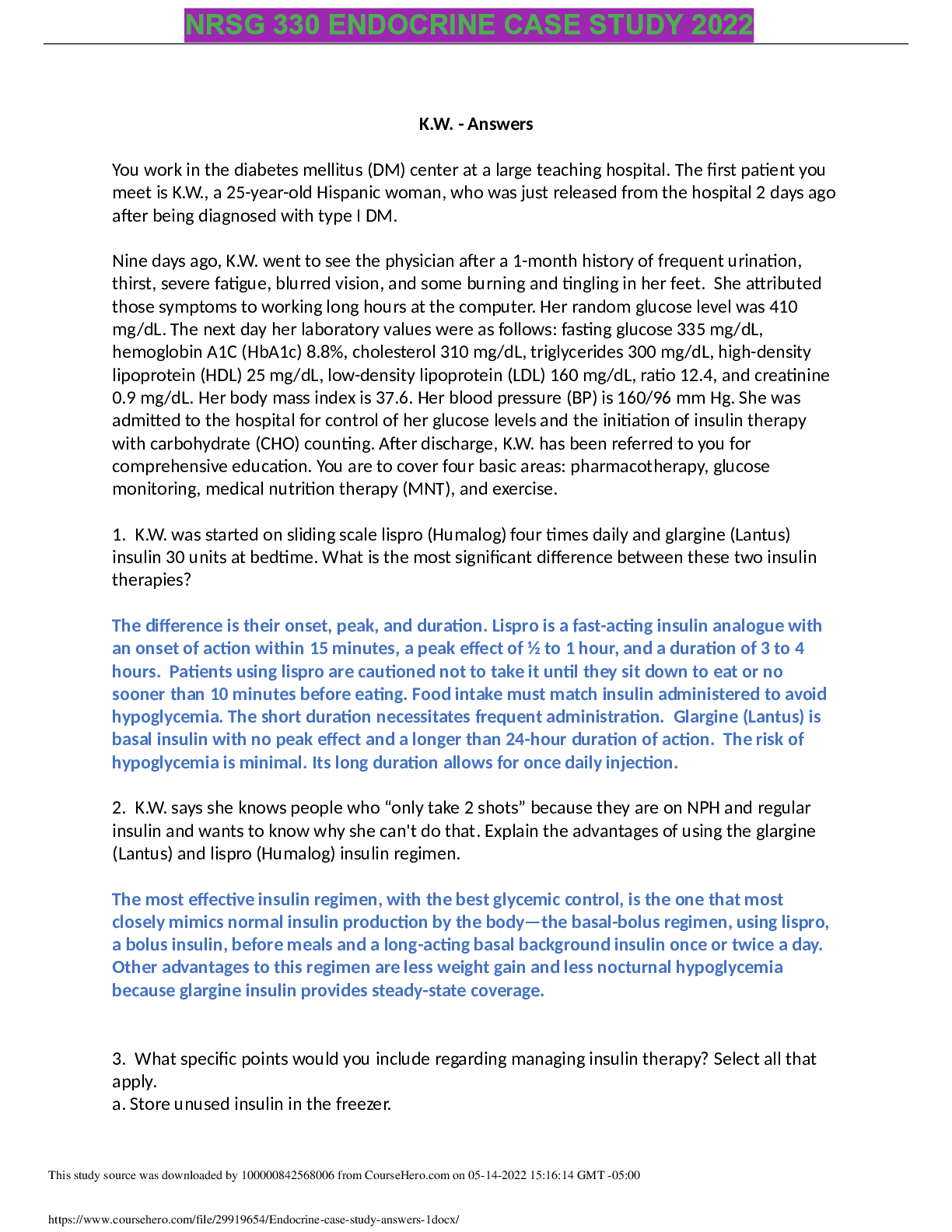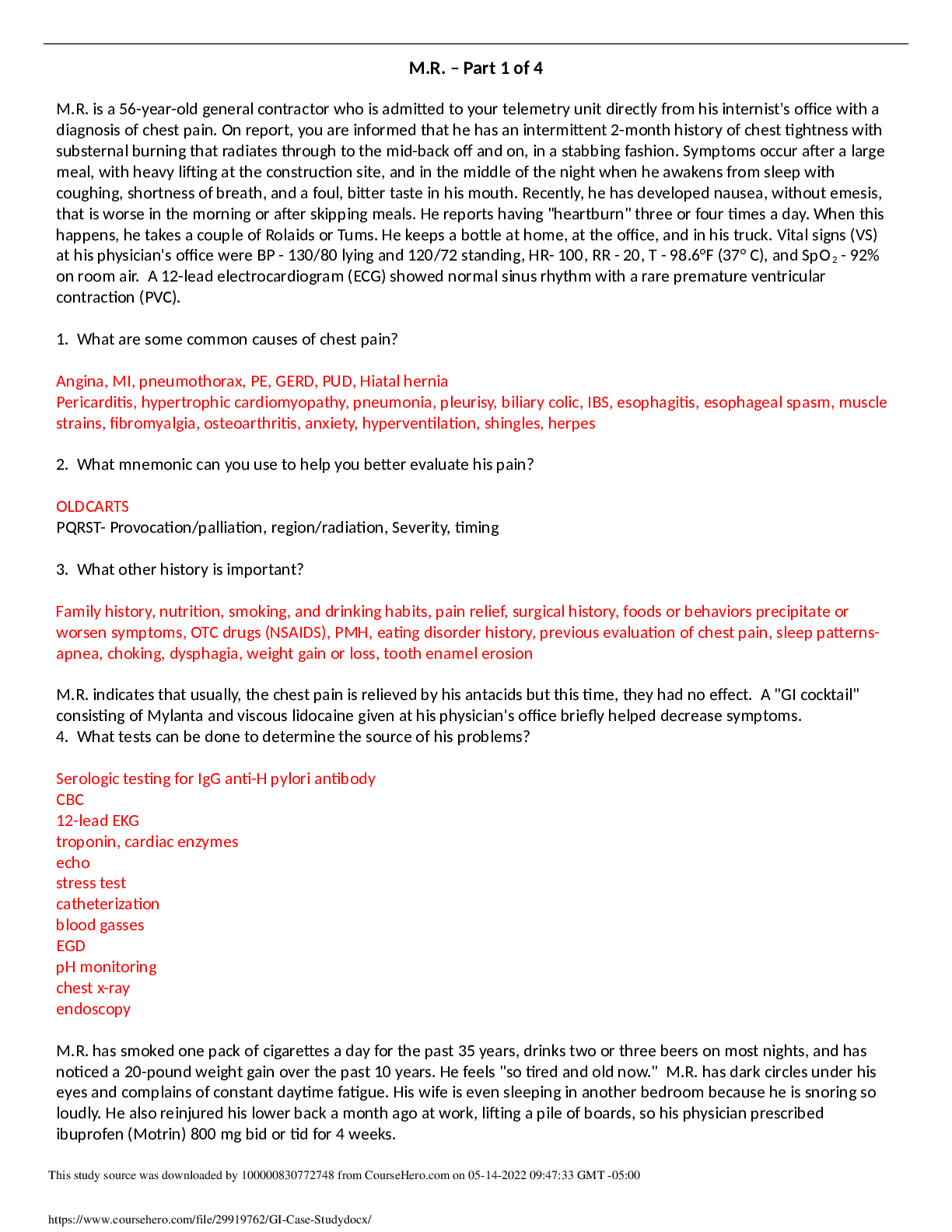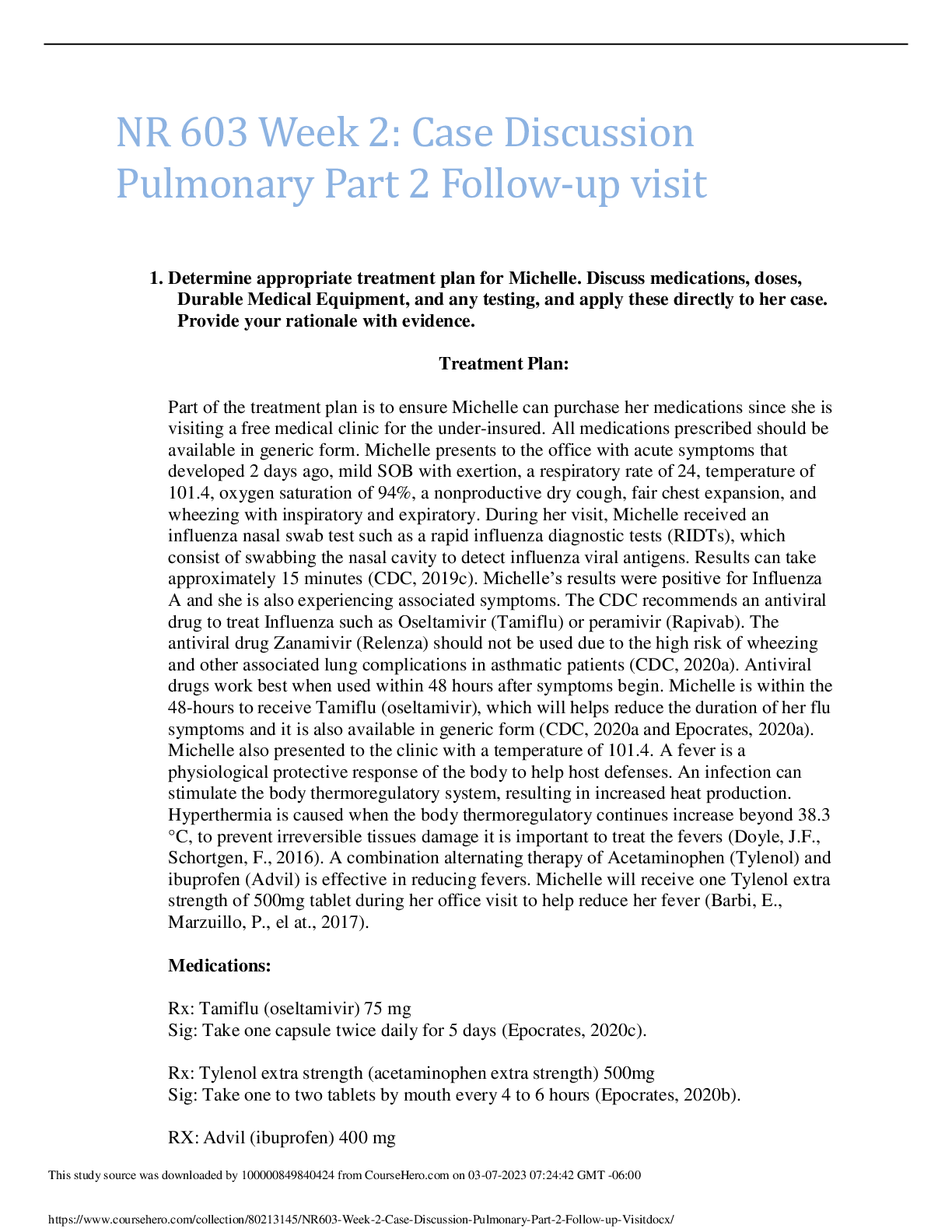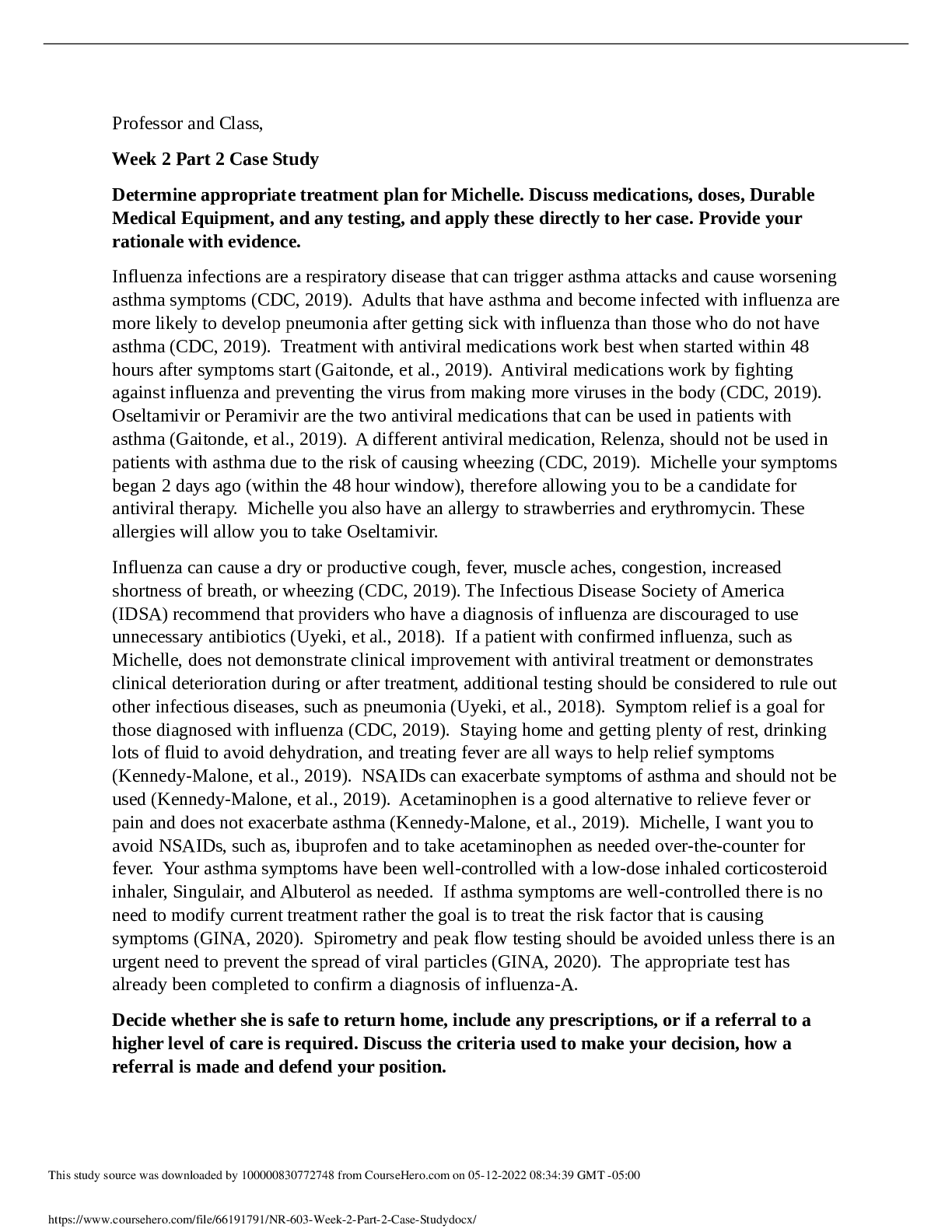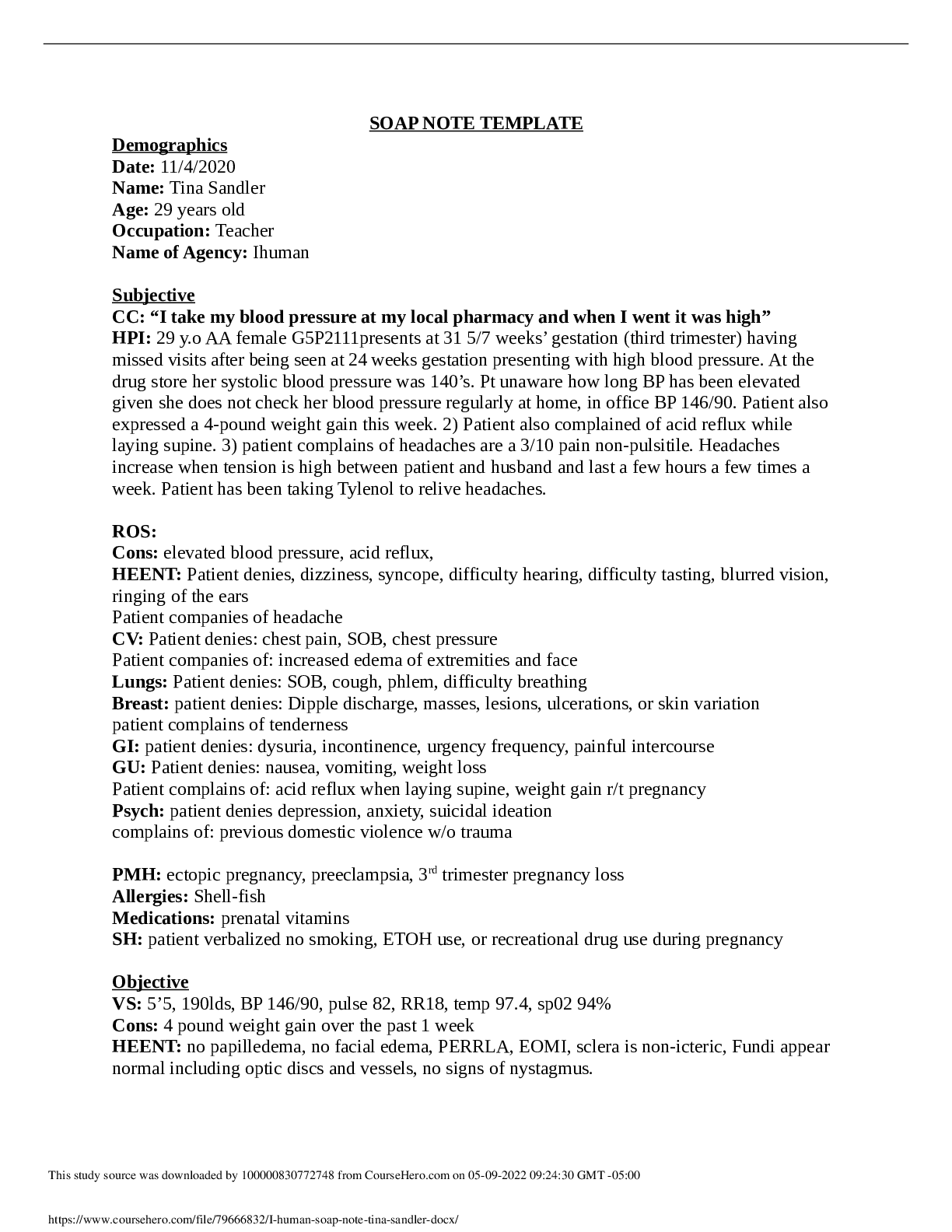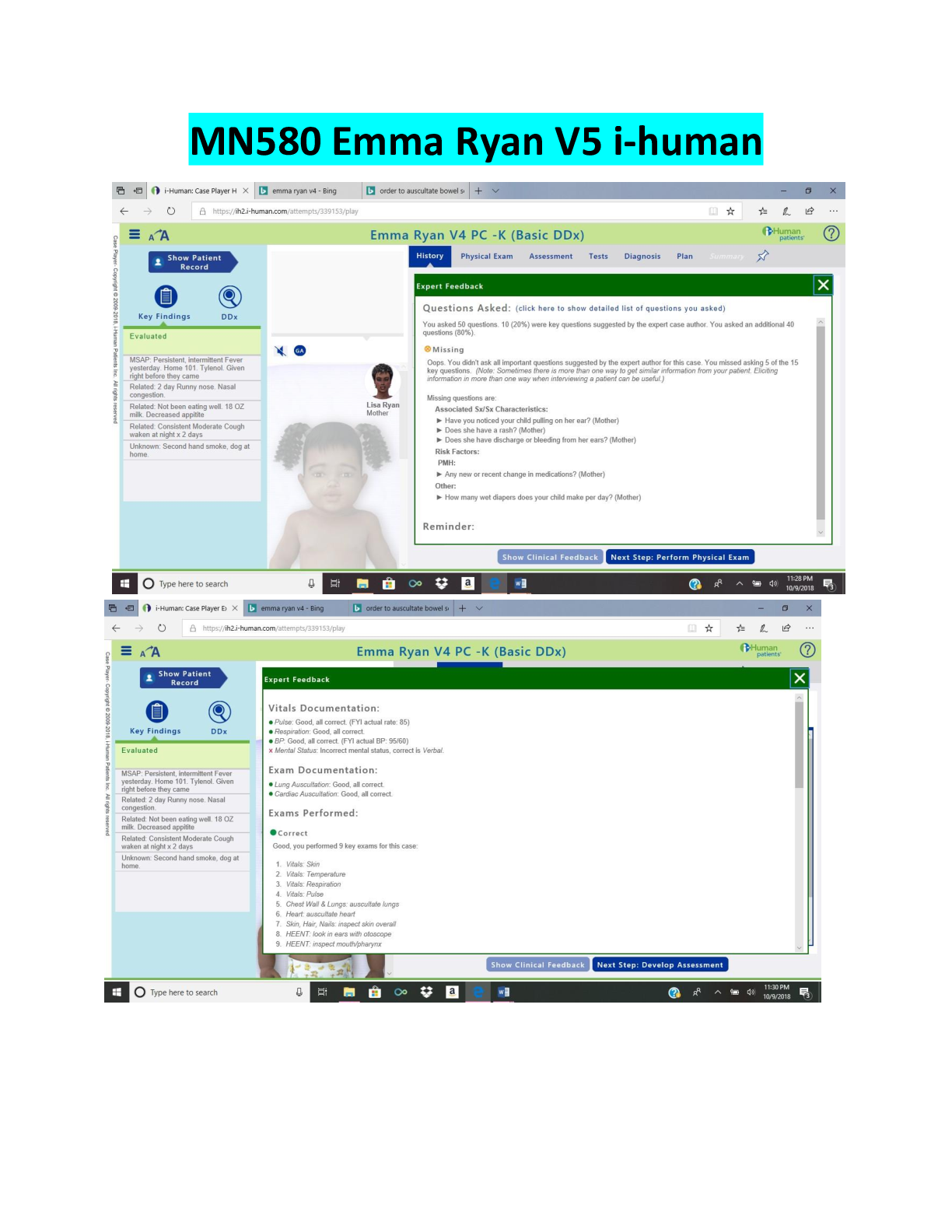Health Care > CASE STUDY > Betty Burns Part 1 V3 PC -K (Basic DDx) 48 years 5' 6" (All)
Betty Burns Part 1 V3 PC -K (Basic DDx) 48 years 5' 6"
Document Content and Description Below
Below are the instructions for playing this DDx. case and your grading rubric: Note you will be allowed to push the Interview Progress Button and receive feedback on your history questions 10 times. ... a) % required history questions you asked (30% of grade) b) % required physical exam performed (30% of grade) c) differential diagnoses list (15%) d) ranking differential diagnosis list (10%) e) laboratory tests ordered (15%) Notice that getting the correct final diagnosis is not part of the graded case. This is because if you do well in each of the other parts, you WILL get the correct diagnosis. The software platform is designed to help you become proficient in the diagnostic reasoning process (all the steps prior to the final diagnosis), so you can apply this process in the real clinic setting. Key to minimizing medical errors is the clinical consideration of a broad differential diagnosis list and the selection of tests to either “rule in” or “rule out” these diagnoses. **** HELPFUL HINTS **** The Avatars and cases in the IHP case library are based on “real patients”. If the Avatar provides confusing information, this is intentional as we often what we find real patients provide incongruent information. For example, the Avatar may use the term “rash” for skin lesions that are not by medical definition a rash---just like real patients. Avatars may refuse to answer questions, just like real patients. Phrasing of questions IS important. Asking a “similar” question that is less specific may not be scored correct if it does not provide the clarity of information needed to narrow the differential. All of these small nuances in the case design were intentional and replicate the challenges you will face with real patients in a clinical setting. My recommendation is to pretend this is a real clinical patient encounter and select a time so you can enjoy the process and not feel pressured for time. Remember, you are not scored on whether you get the diagnosis correct, but rather have you mastered the process. Mastery of the process will help you avoid making diagnostic errors throughout your clinical career. Detailed Instructions Below: 1. Take the patient's history. Decide of this is a patient that can be treated as an outpatient; focused case – fewer history questions needed versus a comprehensive case where all components of a history. Document the chief complaint Document any abnormal history or complaints on your problem list The Interview Progress Button can be used up to 10 times on the practice cases only to give you feedback on how close you are to asking all the authors “required questions”. 2. Proceed to perform a PHYSICAL EXAM. Assess vital signs and perform the examination appropriate for the type of case identified by the above history. Remember the comprehensive cases require a comprehensive physical. Document abnormal findings in your problem list. 3. Be sure to complete the problem list exercise. The directions will tell you how many items should be chosen. DO NOT exceed that number or your score will be zero. 4. Write a concise problem statement. Start with a demographic description of your patient and the chief complaint and MSAP. Try to keep your problem statement below 100 words. Although this will not count towards your final case score, it will allow you to practice learning to communicate patient information in a complete and concise fashion. 5. Finalize your differential diagnosis list. You may start your differential diagnosis during the history taking section, but after completing the problem statement, reflect and finalize your differential diagnosis list. Remember, this part of the case will be scored on how comprehensive this list is. You will not lose points for having too many, points are lost only if you have too few. The average list contains 5 diagnoses. 6. Order Tests Order each test and link it to a diagnosis. Some tests are ordered to “rule in” a diagnosis while others are ordered to “rule out” a diagnosis. DO NOT try to scam the system by just clicking on everything. The software tracks not only what is done, but also keeps track of the order of completion. Clicking on the first opening question and then just going down the list of questions in the history is viewed as “scamming” the system and can result in a score of ZERO---same principle applies to each section. The time for completion of the case, as well as time spent in each section of the case is also recorded. This data has been shown to correlate with case performance. Very short times have lower scores as do very long times. The former is most likely due to lack of effort while the latter may be because the user is receiving multiple interruptions. The low score then most likely reflects “lack of continuity” of thought. Try to set aside enough time to complete the case in its entirety in a single sitting. This software is aimed at trying to help assess your critical thinking and diagnostic reasoning skills with patients similar to those you will be seeing in the clinical setting. It is extremely important for you to take these cases seriously as they will be used to determine how appropriate your interactions are with patients and if your clinical decision making skills are appropriate for this level in the program. HISTORY You asked 66 questions. 10 (15%) were key questions suggested by the expert case author. You asked an additional 56 questions (85%). M iss ing Oops. You didn't ask all important questions suggested by the expert author for this case. You missed asking 11 of the 21 key questions. (Note: Sometimes there is more than one way to get similar information from your patient. Eliciting information in more than one way when interviewing a patient can be useful.) Missing questions are: Associated Sx/Sx Characteristics: Do you have any breast lump or discharge? Risk Factors: PMH: Any new or recent change in medications? HPI/ROS: Do you have any of the following problems: fatigue, difficulty sleeping, unintentional weight loss or gain, fevers, night sweats? Do you have any problems with: headaches that don’t go away with aspirin or Tylenol (acetaminophen), double or blurred vision, difficulty with night vision, problems hearing, ear pain, sinus problems, chronic sore throats, difficulty swallowing? Do you experience: chest pain, discomfort, pressure, pain/pressure/dizziness with exertion or getting angry, palpitations, decreased exercise tolerance, blue/cold fingers and toes? Do you experience: shortness of breath, wheezing, difficulty catching your breath, chronic cough, sputum production? Do you have problems with: nausea, vomiting, constipation, diarrhea, coffee grounds in your vomit, dark tarry stool, bright red blood in your bowel movements, early satiety, bloating? Have you noticed: any bruising, bleeding gums or other sites of increased bleeding? Do you have any of the following: heat or cold intolerance, increased thirst, sweating, frequent urination, change in appetite? Do you have any of the following: dizziness, fainting, spinning room, seizures, weakness, numbness, tingling, tremor? When you urinate, have you noticed: pain, difficulty starting or stopping, dribbling, incontinence, urgency during day or night. Any changes in frequency? Any blood in your urine? Rem inder: Be sure to fill out appropriate portions of the Patient Record before proceeding. PHYSICAL EXAM Vita ls Documentat ion: Pulse: You did not complete documentation for this required exam. Incorrect rate, correct is 80. Incorrect rhythm, correct is regular. Incorrect strength, correct is normal. Respiration: You did not complete documentation for this required exam. Incorrect rate, correct is 16. Incorrect rhythm, correct is regular. Incorrect effort, correct is normal. BP: You did not complete documentation for this required exam. Incorrect systolic, correct is 128. Incorrect diastolic, correct is 80. Incorrect assessment, correct is normal. Incorrect pulse pressure, correct is normal. [Show More]
Last updated: 1 year ago
Preview 1 out of 15 pages

Buy this document to get the full access instantly
Instant Download Access after purchase
Add to cartInstant download
We Accept:

Reviews( 0 )
$7.00
Document information
Connected school, study & course
About the document
Uploaded On
Jan 18, 2023
Number of pages
15
Written in
Additional information
This document has been written for:
Uploaded
Jan 18, 2023
Downloads
0
Views
26


 (1).png)

